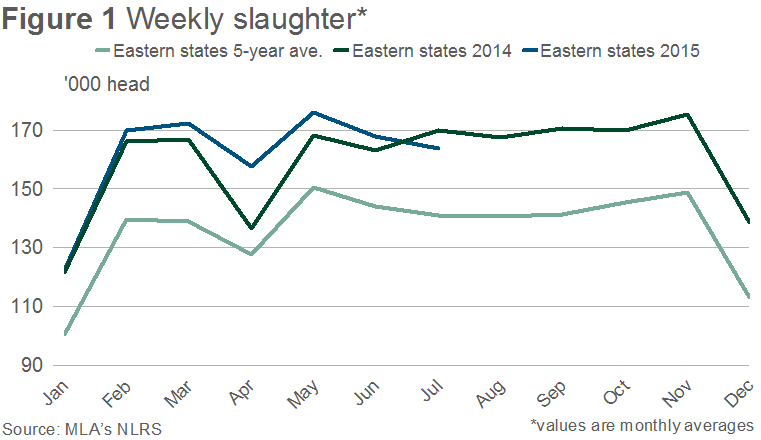Subscribe to The Weekly e-newsletter
For in-depth red meat market news, information and analysis.
Queensland cattle kill finally slows, OTH prices rise
05 August 2015
For the fifth consecutive week, the eastern states weekly cattle slaughter, as reported by MLA’s National Livestock Reporting Service, has tracked below year-ago levels.
Up until last week, the decline was driven by reduced kills in the southern states, with Victoria and NSW back 18% and 6% year-on-year, respectively. However, with a tightening supply scenario and rising over-the-hook price indicators unfolding in the north, Queensland adult cattle slaughter last week finally slowed, with just over 84,000 head processed – 5% below the previous week and the smallest kill since February (excluding weeks with public holidays).
However, given 2015 has been a historically high year for cattle slaughter, the current number of cattle being processed is still above the long term average. Table 1 below outlines where the current slaughter levels are positioned and, compared with pre-drought years, they are still elevated across the board.

With processors reportedly finding it increasingly difficult to source cattle, over-the-hook indicators have consistently risen in recent weeks. Some of the strongest increases this week were recorded across Queensland grids, with most indicators increasing about 6-14¢/kg cwt week-on-week. However, with the exception of the cow category, indicators in the north are still tracking below those in NSW and Victoria, as illustrated in Table 2.

Looking ahead, as illustrated by the 5-year average weekly kill in Figure 1, slaughter typically reaches a seasonal low over the coming months, particularly in the southern states, so a further contraction may occur before picking up in October and November. This decline is in line with MLA’s latest quarterly industry projections, with national cattle slaughter forecast to reach 9 million head in 2015, back 2% on 2014 levels. However, supplies still have a long way to fall before we see levels consistent with years prior to the elevated drought-induced turnoff.

For the full list of MLA’s slaughter reports, please click here.


